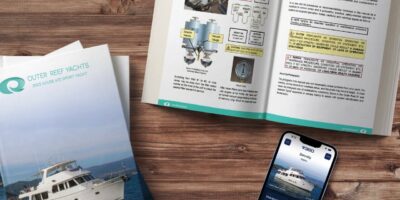Inspecting Marine Gasoline Engines
Some simple tricks to help you evaluate your engines condition and head off trouble before it gets started.
- January 16, 2024
Reading through the claim files, you get the uneasy sense that most skippers didn’t have a clue their engines were developing a serious problem until the minute that they sputtered and died. Unlike an automobile’s engine, which tends to run and run until the car is traded in, a boat’s engine is more likely to develop problems, even when it is relatively new. These problems are considered normal wear and tear, and are not likely to be covered by a boat’s insurance policy.
There are three reasons for this disparity between automobile and marine engines. First, a boat’s engine works much harder than an automobile engine — up to twice as hard. While an automobile engine “strolls” through most of its life, a boat’s engine has to spend many hours swimming upstream. Second, the boat’s engine works in a much more hostile environment, water, often saltwater, which can corrode vital parts quickly. And, finally, marine engines develop problems because they are sometimes idle for weeks or even months. If they aren’t laid up properly, and many aren’t, this idleness encourages rust on internal parts, which is a major source of damage in marine engines (Seaworthy, October 1995).
How healthy is your engine? One obvious clue to an engine’s condition is its age. While operating hours are certainly a factor, the number of hours on an engine doesn’t bother mechanics as much as the number of years it has been in service. Marine mechanics report that a commercial boat engine that is used every day will often be in better shape mechanically after several thousand hours of use than a recreational boat’s engine with only 500 hours.
In this issue of Seaworthy, we’ll give you some simple tricks for diagnosing the condition of your boat’s engine. These tricks won’t tell you everything about your engine, but you’ll have a better idea of what’s going on internally and when to contact a mechanic to make adjustments that might save on more costly repairs later.
Examining The Oil
The number one rule of any 4-cycle engine is to change the oil and oil filter routinely, according to manufacturer’s recommendations. Oil’s role in keeping the engine running is critical — it lubricates all bearing surfaces as well as the crankshaft and camshaft bearings, timing gears, pistons, and valves. Marine engines must work very hard, and an oil cooler must be used in most engines to reduce the high internal temperatures.
Some things to look for in the oil:
- Pull the dipstick and smell the oil. A strong burnt smell indicates the engine has been overheating — not a good sign. Next, wipe the dipstick on a clean white napkin. Oil that is thick initially and then slowly spreads over the napkin indicates the presence of fuel, which usually means that an overrich fuel condition (often caused by a sticky choke) is allowing fuel to leak past the rings into the oil. This condition can cause premature wear on bearings, rings, and pistons. If either condition exists — burnt oil or fuel in the oil — contact a mechanic.
- Check under the oil filler cap, which is at the highest point in the system, as well as inside the valve cover (use your finger) for indications of condensation and/or rust. The latter is the #1 enemy of marine engines. When oil contains a lot of water it looks creamy or “frothy”, although this might not be apparent until the engine has been running for awhile. Even if the oil looks clean, you can put a drop or two on something hot, like a coffee maker burner. The drop should have a smooth edge — a jagged edge indicates water. Depending on the amount of water you suspect is in the oil — this is a judgment call and you may want to consult a mechanic — the engine could have a serious problem. Some condensation is to be expected, especially if the boat has been idle for a long time. Too much water, however, can indicate a blown head gasket, a cracked cylinder head, or a corroded cylinder liner.
- Oil pressure should be noted at start-up and then again after the engine has warmed, to make sure it is up to manufacturer’s specs. Low oil pressure at start-up — below about 25-30 (this varies by manufacturer, so check your manual) indicates a potential problem with the cam bearings, oil pump, or a faulty pressure sending unit.
- Oil tests are relatively inexpensive, can be done by a boat owner, and tell you what’s in the oil — metals, water, or fuel. A test’s value, however, depends on how recently the oil has been changed. To be effective, the oil being tested should have been in use for several weeks. Samples should be taken from the mid-sump area after the engine is warmed. Taking several oil samples over a period of months or years tells you a lot more than taking a single oil sample. Contact local auto supply stores like NAPA, if they don’t have the kits, the store manager should be able to recommend someone who does.
- Pull the plugs. Tips that are a brown or beige color indicate normal combustion, while a gray color indicates detonation (Seaworthy, January 1996) in the cylinder.
The Cooling System
According to the claim files, manifold and risers are one of the most likely areas to fail and cause trouble. Water and gases travel through the manifold in separate pipes before combining at the riser and being discharged overboard. Keeping the water and gases separated in the manifold is critical; over time the manifold will corrode, which will allow water to enter the cylinders and wreck the engine.
How long it takes for the manifold and risers to corrode depends on where you do your boating (Seaworthy, April 1996). In saltwater, they may need to be replaced after only three years. In freshwater, mechanics say the manifold and risers could last much longer. As the cast iron parts begin to corrode, rust will often restrict the flow of cooling water, threatening the life of the engine. Any drop in temperature should be taken seriously, but the lack of cooling water isn’t always indicated on the engine’s temperature gauge. Some clues to the condition of your cooling system:
- You can get at least a crude indication of the manifold’s condition by flicking a couple of drops of water on the top of each riser. If both risers are running at the same temperature, the water will evaporate at the same rate. If, however, the water dissipates off of one riser much faster, there is a water flow restriction. A better indication can be had by contacting a mechanic with a digital readout infrared thermometer (the cost for a thermometer is about $175 if you’re inclined to do it yourself) that indicates hot spots on a manifold. Concentrations of heat indicate that the manifold needs to be taken off and either cleaned or replaced — a common condition on many engines.
- If the engine has been losing power, another test can be used to learn if it is being caused by exhaust gases leaking into the cooling system. A Combustion Leak Test Kit costs about $40. and comes with an graduated vile and eight or 10 tests worth of a blue liquid that changes to yellow if exhaust gases are present, indicating either a cracked or warped cylinder head, cracked block, leaking valve seat, or a leaking head gasket.
NOTE: Always check the hoses when you encounter a manifold or riser problem. As water leaves the riser, it cools the hoses. If water flow at the riser has been restricted, the water flow will have been reduced, and the result could be serious damage to the exhaust hoses.
With The Engine Running
Reading exhaust smoke:
- Running an engine tells you a lot about its condition. Hard starting could indicate a problem with the plugs, battery, or fuel pump. Immediately after it starts, look for smoke. With gasoline engines (both outboards and inboards), some smoke, either black or blue, is to be expected when the engine is first started, but the extra smoke shouldn’t persist for more than five or 10 seconds. Excessive smoke that lasts for up to a minute after start-up indicates a possible problem with the fuel mixture (black smoke) or oil leaking past the valve guides or seals and accumulating in the combustion chamber (blue smoke). With the latter, an engine will consume more oil and performance may suffer slightly, but the condition isn’t terminal. Black smoke, on the other hand, could be indicating fuel dilution, which leads to premature bearing failure if it isn’t corrected. Excessive smoke that lasts more than a minute can indicate worn rings.
- Too much exhaust steam — this is another judgment call — means that water is getting into the combustion chamber via a head gasket or a problem with the manifold. A “steaming engine” should be checked by a mechanic. (Steam is easily identified because it rises more quickly than smoke, which tends to stay near the water.)
- When it comes to analyzing your engine there is no substitute for a boat ride. If the engine won’t operate somewhere around 4,200 – 4,600 rpm’s — the operating range where most engines make their maximum horsepower — it usually indicates a problem. (Consult your manual again, as maximum rpm’s varies from engine to engine.) The problem could be your prop (either the wrong size or pitch), which will shorten engine life by creating additional heat, wear, and friction. Other possible causes include back-pressure in the exhaust pipe or the incorrect reduction gearbox. The problem could also be something as simple as poor ventilation. If opening the engine hatch increases rpm’s, you need better ventilation. If this doesn’t correct the problem, further investigation by a mechanic is called for.
- A mechanic should also be summoned if the engine is “missing” — sputtering, coughing, or running rough. This can be caused by water in the fuel, but more often it is a problem with the ignition system — spark plug wires, plugs, rotor, or a worn timing chain. Also, be alert for excessive vibration, which could indicate a bent prop, a bent shaft, engine misalignment, or a problem with the engine coupling.
- A Cylinder Leak Test Kit can be used by a mechanic to tell you if (and how badly) your valves are leaking. Symptoms include backfiring, overheating, and loss of power. In some cases, the boat may not plane. Leaking valves create a lean fuel condition (too much air and not enough fuel), which accelerates valve wear.
Checking Compression
If you suspect a problem with one of the cylinders ( a sudden loss of power or excessive black smoke), a mechanic should be summoned to do a compression test, preferably with an Engine Analyzer. This gadget uses a computer to give a more accurate compression readouts than can be had with conventional compression tests, which only indicate gross malfunctions.
Using probes hooked to spark plugs, the machine shorts out one cylinder at a time to measure the drops in RPM. The results are computed on a bar graph so that the mechanic can see exactly which cylinders are weak and which are strong. (A variation of 20% or more, either from the other cylinders or from OEM specifications, is significant.)
If the analyzer (or a conventional compression test) indicates a weak cylinder, a simple follow-up test by the mechanic will indicate whether rings are the problem or whether the engine has a less serious valve problem: Pour one tablespoon of oil (any more will hydraulic the cylinder and give a false reading ) in the cylinder and repeat the test. If the reading on the weak cylinder is equal to the reading on the strong cylinders, the problem is rings (ouch!). If the numbers continue to indicate a weak cylinder, valves are the problem.
Examining Hoses And Belts
Engine hoses should be checked to see that all are healthy. A Napa publication on belts and hoses reports that most engine hoses fail from the inside out as the result of an electrochemical reaction (called “electrochemical degradation” or ECD) that occurs as the hose ages and tiny cracks form in the rubber. These cracks then absorb coolant in the freshwater cooling system, which attacks and weakens the hose’s reinforcement. (Mechanics report seeing the same condition on hoses in the raw-water portion of the cooling system, especially when the boat is used in saltwater.)
ECD can be detected by squeezing the thumb and a finger on the hose about 2″ from the clamp. If the ends of the hose feel soft and mushy, the chances are good that it is breaking down internally and it should be replaced. The article recommends checking the middle of the hose, as well as the ends, to discover differences in softness. Gaps or channels that can be felt along the length of the hose also indicate impending failure.
A Few Suggestions
- Keep your engine (and bilge) clean. While this does little for the engine, per se, a clean engine will be easier to inspect and maintain which could give you an early indication of a potential problem. “Heavy” rust and scale on an engine should be sanded and painted. The exception is exhaust manifolds, which don’t hold paint and are typically rusted. Spend time reading your engine manual. Rather than rely on your aging memory, keep careful records of maintenance and repairs; you’ll have an easier time keeping track of what has been done and when it was done.
- Check the zinc at the heat exchanger (a relatively simple job). A zinc that is more than half eaten away should be replaced.
- If you’re buying a used boat: look for excess gasket residue and new paint, which is often found on rebuilt engines. If an engine was rebuilt, it’s a good idea to find out who did the work and then check to see exactly what was (or wasn’t) done. With some engines, problems tend to be ongoing and you don’t want to buy someone else’s headache.
If you have doubts, confirm the motor’s serial and model numbers (and outdrive number, if applicable) and contact the manufacturer. This can usually be done with one or two phone calls. Manufacturers have motor, outdrive, and transmission information, including major repairs and recalls. Their records can often be used to ascertain the date of manufacture, shipping location, and original owner.
BoatUS Editors
Contributor, BoatUS Magazine
About Vessel Vanguard
Vessel Vanguard is a leading marine safety and maintenance management software provider dedicated to revolutionizing the maritime industry. With a commitment to innovation and excellence, Vessel Vanguard delivers cutting-edge solutions to streamline operations and enhance vessel performance and safety.
Latest Industry Insights

Embracing E-Boating Efficiencies

Boat Fuel Systems

The Future of Boats & Boating

Yacht Navigation Light Inspection
View All of Our Industry Insights
Navigate maritime with the latest news, practical how-to guides, insightful analyses and more.
